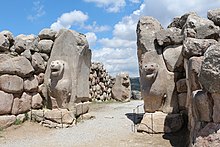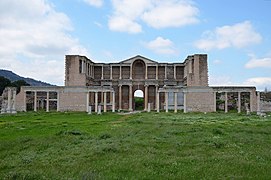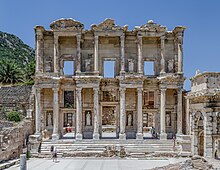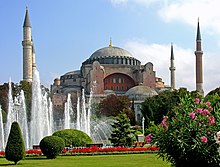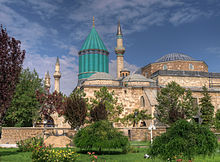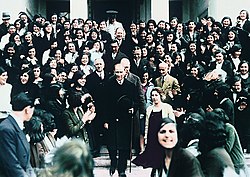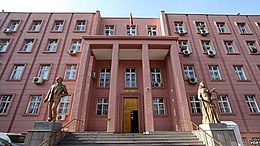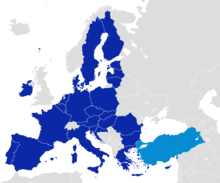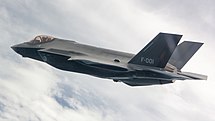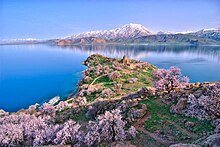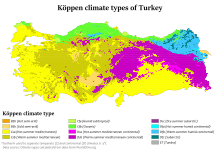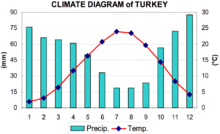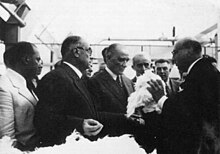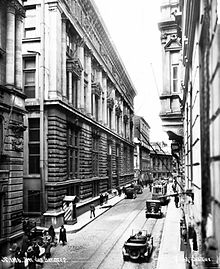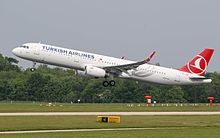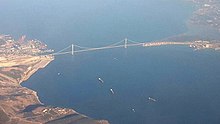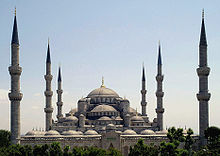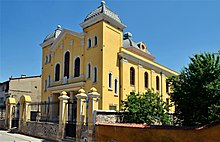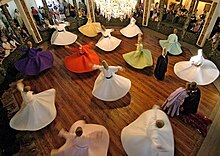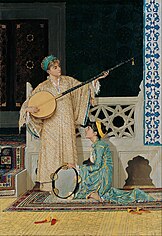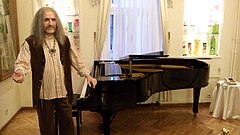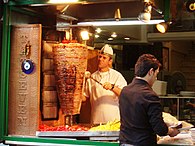Turkey
Definition
Turkey (Turkish: Türkiye [ˈtyɾcije]), officially the Republic of Turkey (Turkish: Türkiye Cumhuriyeti [ˈtyɾcije d͡ʒumˈhuɾijeti] (Approximately 70–80% of the country's citizens identify themselves as ethnic Turks. Kurds are the largest minority at about 20% of the population; other ethnic minorities include Circassians, Albanians, Arabs, Bosniaks, and Laz people. The official language is Turkish, which is the most widely spoken Turkic language in the world. Minority languages spoken today in Turkey include Kurmanji, Bosnian, Arabic, Zaza, Kabardian, and several others.
The area of Turkey has been inhabited since the Paleolithic age by various ancient Anatolian civilisations, as well as Assyrians, Greeks, Thracians, Phrygians, Urartians, and Armenians. After Alexander the Great conquered these lands, the area was Hellenized, a process which continued under the Roman Empire and its transition into the Byzantine Empire. The Seljuk Turks began migrating into the area in the 11th century, and their victory over the Byzantines at the Battle of Manzikert in 1071 symbolizes the start and foundation of Turkey. The Seljuk Sultanate of Rûm ruled Anatolia until the Mongol invasion in 1243, when it disintegrated into small Turkish principalities.
From the end of the 13th century the Ottomans started uniting these Turkish principalities in Anatolia and then went on to create an empire that encompassed much of Southeast Europe, West Asia and North Africa. The Ottoman Empire became a world power beginning with the reign of Suleiman the Magnificent in the early modern period. It remained powerful and influential for two more centuries, until important setbacks in the 19th and 20th century forced it to cede strategic territories in Europe, which signalled the loss of its former military strength and wealth. After the 1913 Ottoman coup d'état, which effectively put the country under the control of the Three Pashas, the Ottoman Empire decided to join the Central Powers during World War I. During the war, the Ottoman government committed genocides against its Armenian, Assyrian and Pontic Greek subjects. Following the war, the conglomeration of territories and peoples that formerly comprised the Ottoman Empire was partitioned into several new states. The Turkish War of Independence, initiated by Mustafa Kemal Atatürk and his colleagues against occupying Allies, resulted in the abolition of monarchy in 1922 and the establishment of the Republic of Turkey in 1923, with Atatürk as its first president. Atatürk enacted numerous reforms, many of which incorporated various aspects of Western thought, philosophy, and customs into the new form of Turkish government.
Turkey is a charter member of the UN, an early member of NATO, the IMF and the World Bank, and a founding member of the OECD, OSCE, BSEC, OICand G-20. After becoming one of the first members of the Council of Europe in 1949, Turkey became an associate member of the EEC in 1963, joined the EU Customs Union in 1995 and started accession negotiations with the European Union in 2005 which have been effectively stopped by the EU in 2017 due to "Turkey’s path toward autocratic rule". Turkey's economy and diplomatic initiatives led to its recognition as a regional power while its location has given it geopolitical and strategic importance throughout history. Turkey is a secular, unitary, formerly parliamentary republic which adopted a presidential system with a referendum in 2017; the new system came into effect with the presidential election in 2018. Turkey's current administration headed by president Recep Tayyip Erdoğan of the AKP has enacted measures to increase the influence of Islam, reversed and undermined Kemalist policies, and has reversed earlier reforms such as freedom of the press.
Etymology
The name of Turkey (Turkish: Türkiye) can be divided into two components: the ethnonym Türk (Old Turkic: 𐱅𐰇𐰼𐰰 Türk) and the abstract suffix –iye meaning "owner", "land of" or "related to" (originally derived from the Greek and Latin suffixes –ia in Tourkia (Τουρκία) and Turchia; and later from the corresponding Arabic suffix –iyya in Turkiyya (تركيا).) The first recorded use of the term "Türk" or "Türük" as an autonym is contained in the Old Turkic inscriptions of the Göktürks (Celestial Turks) of Central Asia (c. AD 735). The Turkic self-designation Türk is first attested in reference to the Göktürksin the 6th century AD. A letter by Ishbara Qaghan to Emperor Wen of Sui in 585 described him as "the Great Turk Khan." An early form of the same name may be reflected in the form of "tie-le" (鐵勒) or "tu-jue" (突厥), name given by the Chinese to the people living south of the Altay Mountains of Central Asia as early as 177 BC. The Greek name, Tourkia (Greek: Τουρκία) was used by the Byzantineemperor and scholar Constantine VII Porphyrogenitus in his book De Administrando Imperio, though in his use, "Turks" always referred to Magyars. The name Tourkia was used by the Byzantines to define Hungary in a Greek inscription dedicated to Hungarian King Géza I (r. 1074–1077) on the corona graeca section of the Holy Crown of Hungary. Similarly, the medieval Khazar Empire, a Turkic state on the northern shores of the Black and Caspian seas, was referred to as Tourkia (Land of the Turks) in Byzantine sources. However, the Byzantines later began using this name to define the Seljuk-controlled parts of Anatolia in the centuries that followed the Battle of Manzikert in 1071. The medieval Greek and Latin terms did not designate the same geographic area now known as Turkey. Instead, they were mostly synonymous with Tartary, a term including Khazaria and the other khaganates of the Central Asian steppe, until the appearance of the Seljuks and the rise of the Ottoman Empire in the 14th century, reflecting the progress of the Turkic expansion. Historically, the Mamluk Sultanate in Egypt, which was ruled by the Turkic Bahri dynasty, was named by Arabic sources of the period as the State of the Turks (Arabic: دولة الاتراك, Dawlat al-Atrāk; دولة الترك, Dawlat al-Turk; الدولة التركية, al-Dawla al-Turkiyya). The names Turkey and Turkish Empire have often been used in contemporary European sources to define the Ottoman Empire.
History
Prehistory of Anatolia and Eastern Thrace
The Anatolian peninsula, comprising most of modern Turkey, is one of the oldest permanently settled regions in the world. Various ancient Anatolian populations have lived in Anatolia, from at least the Neolithic period until the Hellenistic period. Many of these peoples spoke the Anatolian languages, a branch of the larger Indo-European language family. In fact, given the antiquity of the Indo-European Hittite and Luwian languages, some scholars have proposed Anatolia as the hypothetical centre from which the Indo-European languages radiated. The European part of Turkey, called Eastern Thrace, has also been inhabited since at least forty thousand years ago, and is known to have been in the Neolithic era by about 6000 BC.
Göbekli Tepe is the site of the oldest known man-made religious structure, a temple dating to circa 10,000 BC, while Çatalhöyük is a very large Neolithic and Chalcolithic settlement in southern Anatolia, which existed from approximately 7500 BC to 5700 BC. It is the largest and best-preserved Neolithic site found to date and in July 2012 was inscribed as a UNESCO World Heritage Site. The settlement of Troy started in the Neolithic Age and continued into the Iron Age.
The earliest recorded inhabitants of Anatolia were the Hattians and Hurrians, non-Indo-European peoples who inhabited central and eastern Anatolia, respectively, as early as ca. 2300 BC. Indo-European Hittites came to Anatolia and gradually absorbed the Hattians and Hurrians ca. 2000–1700 BC. The first major empire in the area was founded by the Hittites, from the 18th through the 13th century BC. The Assyrians conquered and settled parts of southeastern Turkey as early as 1950 BC until the year 612 BC. Urartu re-emerged in Assyrian inscriptions in the 9th century BC as a powerful northern rival of Assyria. Following the collapse of the Hittite empire c. 1180 BC, the Phrygians, an Indo-European people, achieved ascendancy in Anatolia until their kingdom was destroyed by the Cimmerians in the 7th century BC. Starting from 714 BC, Urartu shared the same fate and dissolved in 590 BC, when it was conquered by the Medes. The most powerful of Phrygia's successor states were Lydia, Caria and Lycia.
Antiquity
Starting around 1200 BC, the coast of Anatolia was heavily settled by Aeolian and Ionian Greeks. Numerous important cities were founded by these colonists, such as Miletus, Ephesus, Smyrna (now İzmir) and Byzantium (now Istanbul), the latter founded by Greek colonists from Megara in 657 BC. The first state that was called Armenia by neighbouring peoples was the state of the Armenian Orontid dynasty, which included parts of eastern Turkey beginning in the 6th century BC. In Northwest Turkey, the most significant tribal group in Thrace was the Odyrisians, founded by Teres I.
All of modern-day Turkey was conquered by the Persian Achaemenid Empire during the 6th century BC. The Greco-Persian Wars started when the Greek city states on the coast of Anatolia rebelled against Persian rule in 499 BC. The territory of Turkey later fell to Alexander the Great in 334 BC, which led to increasing cultural homogeneity and Hellenization in the area.
Following Alexander's death in 323 BC, Anatolia was subsequently divided into a number of small Hellenistic kingdoms, all of which became part of the Roman Republic by the mid-1st century BC. The process of Hellenization that began with Alexander's conquest accelerated under Roman rule, and by the early centuries of the Christian Era, the local Anatolian languagesand cultures had become extinct, being largely replaced by ancient Greek language and culture. From the 1st century BC up to the 3rd century CE, large parts of modern-day Turkey were contested between the Romans and neighbouring Parthians through the frequent Roman-Parthian Wars.
Early Christian and Byzantine period
According to Acts of Apostles 11, a city in the southern of Turkey, Antioch (now Antakya) is the birthplace of the first Christian community.
In 324, Constantine I chose Byzantium to be the new capital of the Roman Empire, renaming it New Rome. Following the death of Theodosius I in 395 and the permanent division of the Roman Empire between his two sons, the city, which would popularly come to be known as Constantinople, became the capital of the Eastern Roman Empire. This empire, which would later be branded by historians as the Byzantine Empire, ruled most of the territory of present-day Turkey until the Late Middle Ages; although the eastern regions remained in firm Sasanian hands up to the first half of the seventh century. The frequent Byzantine-Sassanid Wars, as part of the centuries long-lasting Roman-Persian Wars, fought between the neighbouring rivalling Byzantines and Sasanians, took place in various parts of present-day Turkey and decided much of the latter's history from the fourth century up to the first half of the seventh century.
Several cities in Turkey, such as Istanbul (Constantinople), Iznik (Nicaea), and Selçuk (Ephesus) were the hosts of ecumenical gatherings in early Christianity.
Seljuks and the Ottoman Empire
The House of Seljuk was a branch of the Kınık Oğuz Turks who resided on the periphery of the Muslim world, in the Yabgu Khaganate of the Oğuz confederacy, to the north of the Caspian and Aral Seas, in the 9th century. In the 10th century, the Seljuks started migrating from their ancestral homeland into Persia, which became the administrative core of the Great Seljuk Empire, after its foundation by Tughril.
In the latter half of the 11th century, the Seljuk Turks began penetrating into medieval Armenia and the eastern regions of Anatolia. In 1071, the Seljuks defeated the Byzantines at the Battle of Manzikert, starting the Turkification process in the area; the Turkish language and Islam were introduced to Armenia and Anatolia, gradually spreading throughout the region. The slow transition from a predominantly Christian and Greek-speaking Anatolia to a predominantly Muslim and Turkish-speaking one was underway. The Mevlevi Order of dervishes, which was established in Konya during the 13th century by Sufi poet Celaleddin Rumi, played a significant role in the Islamization of the diverse people of Anatolia who had previously been Hellenized. Thus, alongside the Turkification of the territory, the culturally PersianizedSeljuks set the basis for a Turko-Persian principal culture in Anatolia, which their eventual successors, the Ottomans, would take over.
In 1243, the Seljuk armies were defeated by the Mongols at the Battle of Köse Dağ, causing the Seljuk Empire's power to slowly disintegrate. In its wake, one of the Turkish principalities governed by Osman I would evolve over the next 200 years into the Ottoman Empire. In 1453, the Ottomans completed their conquest of the Byzantine Empire by capturing its capital, Constantinople.
In 1514, Sultan Selim I (1512–1520) successfully expanded the empire's southern and eastern borders by defeating Shah Ismail I of the Safavid dynasty in the Battle of Chaldiran. In 1517, Selim I expanded Ottoman rule into Algeria and Egypt, and created a naval presence in the Red Sea. Subsequently, a contest started between the Ottoman and Portuguese empires to become the dominant sea power in the Indian Ocean, with a number of naval battles in the Red Sea, the Arabian Sea and the Persian Gulf. The Portuguese presence in the Indian Ocean was perceived as a threat to the Ottoman monopoly over the ancient trade routes between East Asia and Western Europe. Despite the increasingly prominent European presence, the Ottoman Empire's trade with the east continued to flourish until the second half of the 18th century.
The Ottoman Empire's power and prestige peaked in the 16th and 17th centuries, particularly during the reign of Suleiman the Magnificent, who personally instituted major legislative changes relating to society, education, taxation and criminal law. The empire was often at odds with the Holy Roman Empire in its steady advance towards Central Europe through the Balkans and the southern part of the Polish-Lithuanian Commonwealth. At sea, the Ottoman Navy contended with several Holy Leagues, such as those in 1538, 1571, 1684 and 1717 (composed primarily of Habsburg Spain, the Republic of Genoa, the Republic of Venice, the Knights of St. John, the Papal States, the Grand Duchy of Tuscany and the Duchy of Savoy), for the control of the Mediterranean Sea. In the east, the Ottomans were often at war with Safavid Persia over conflicts stemming from territorial disputes or religious differences between the 16th and 18th centuries. The Ottoman wars with Persia continued as the Zand, Afsharid, and Qajardynasties succeeded the Safavids in Iran, until the first half of the 19th century. From the 16th to the early 20th centuries, the Ottoman Empire also fought many wars with the Russian Tsardom and Empire. These were initially about Ottoman territorial expansion and consolidation in southeastern and eastern Europe; but starting from the latter half of the 18th century, they became more about the survival of the Ottoman Empire, which had begun to lose its strategic territories on the northern Black Sea coast to the advancing Russians.
From the second half of the 18th century onwards, the Ottoman Empire began to decline. The Tanzimat reforms of the 19th century, which had been instituted by Mahmud II, were aimed to modernise the Ottoman state in line with the progress that had been made in Western Europe. The efforts of Midhat Pasha during the late Tanzimat era led the Ottoman constitutional movement of 1876, which introduced the First Constitutional Era, but these efforts proved to be inadequate in most fields, and failed to stop the dissolution of the empire. As the empire gradually shrank in size, military power and wealth, especially after the Ottoman economic crisis and default in 1875 which led to uprisings in the Balkan provinces that culminated into the Russo-Turkish War of 1877–78, many Balkan Muslims migrated to the Empire's heartland in Anatolia, along with the Circassians fleeing the Russian conquest of the Caucasus. The decline of the Ottoman Empire led to a rise in nationalist sentiment among its various subject peoples, leading to increased ethnic tensions which occasionally burst into violence, such as the Hamidian massacres of Armenians.
The Young Turk Revolution in 1908 restored the Ottoman constitution and parliament 30 years after their suspension by Sultan Abdul Hamid II in 1878, which is known as the Second Constitutional Era, but the 1913 Ottoman coup d'état effectively put the country under the control of the Three Pashas, making sultans Mehmed V and Mehmed VI largely symbolic figureheads with no real political power.
The Ottoman Empire entered World War I on the side of the Central Powers and was ultimately defeated. During the war, the empire's Armenians were deported to Syriaas part of the Armenian Genocide. As a result, an estimated 800,000 to 1,500,000 Armenians were killed. The Turkish government has refused to acknowledge the events as genocide and claims that Armenians were only relocated from the eastern war zone. Genocidal campaigns were also committed against the empire's other minority groups such as the Assyrians and Greeks. Following the Armistice of Mudros on 30 October 1918, the victorious Allied Powerssought to partition the Ottoman state through the 1920 Treaty of Sèvres.
Republic of Turkey
The occupation of Istanbul (1918) and Izmir (1919) by the Allies in the aftermath of World War I prompted the establishment of the Turkish National Movement. Under the leadership of Mustafa Kemal Pasha, a military commander who had distinguished himself during the Battle of Gallipoli, the Turkish War of Independence(1919–1923) was waged with the aim of revoking the terms of the Treaty of Sèvres.
By 18 September 1922 the Greek, Armenian and French armies were expelled, and the Ankara-based Turkish regime, which had declared itself the legitimate government of the country on 23 April 1920, started to formalise the legal transition from the old Ottoman into the new Republican political system. On 1 November 1922, the Turkish Parliament in Ankara formally abolished the Sultanate, thus ending 623 years of monarchical Ottoman rule. The Treaty of Lausanne of 24 July 1923 led to the international recognition of the sovereignty of the newly formed "Republic of Turkey" as the successor state of the Ottoman Empire, and the republic was officially proclaimed on 29 October 1923 in Ankara, the country's new capital. The Lausanne Convention stipulated a population exchange between Greece and Turkey, whereby 1.1 million Greeks left Turkey for Greece in exchange for 380,000 Muslims transferred from Greece to Turkey.
Mustafa Kemal became the republic's first President and subsequently introduced many radical reforms with the aim of transforming the old religion-based and multi-communal Ottoman state system (constitutional monarchy) into an essentially Turkish nation state (parliamentary republic) with a secular constitution. With the Surname Law of 1934, the Turkish Parliament bestowed upon Mustafa Kemal the honorific surname "Atatürk" (Father of the Turks).
İsmet İnönü became Turkey's second President following Atatürk's death on 10 November 1938. In 1939 Turkey annexed the Republic of Hatay. Turkey remained neutral during most of World War II, but entered the closing stages of the war on the side of the Allies on 23 February 1945. On 26 June 1945, Turkey became a charter member of the United Nations. In the following year, the single-party period in Turkey came to an end, with the first multiparty elections in 1946. The Truman Doctrine in 1947 enunciated American intentions to guarantee the security of Turkey and Greece during the Cold War, and resulted in large-scale U.S. military and economic support. In 1948 both countries were included in the Marshall Plan and the OEEC for rebuilding European economies. In 1949 Turkey became a member of the Council of Europe. The Democratic Party established by Celâl Bayar won the 1950, 1954and 1957 general elections and stayed in power for a decade, with Adnan Menderes as the Prime Minister and Bayar as the President. After participating with the United Nations forces in the Korean War, Turkey joined NATO in 1952, becoming a bulwark against Soviet expansion into the Mediterranean. Turkey subsequently became a founding member of the OECD in 1961, and an associate member of the EEC in 1963.
The country's tumultuous transition to multiparty democracy was interrupted by military coups d'état in 1960, 1971, and 1980, as well as a military memorandum in 1997. Between 1960 and the end of the 20th century, the prominent leaders in Turkish politics who achieved multiple election victories were Süleyman Demirel, Bülent Ecevit and Turgut Özal.
Following a decade of Cypriot intercommunal violence and the coup in Cyprus on 15 July 1974 staged by the EOKA B paramilitary organisation, which overthrew President Makarios and installed the pro-Enosis (union with Greece) Nikos Sampson as dictator, Turkey invaded Cyprus on 20 July 1974 by unilaterally exercising Article IV in the Treaty of Guarantee (1960), but without restoring the status quo ante at the end of the military operation. In 1983 the Turkish Republic of Northern Cyprus, which is recognised only by Turkey, was established.The Annan Plan for reunifying the island was supported by the majority of Turkish Cypriots, but rejected by the majority of Greek Cypriots, in separate referendums in 2004. However, negotiations for solving the Cyprus dispute are still ongoing between Turkish Cypriot and Greek Cypriot political leaders.
In 1984, the Kurdistan Workers' Party (PKK), a Kurdish separatist group (listed as a terrorist organization by NATO, the United States and the European Union), began an armed insurgency campaign against Turkey. The conflict has claimed over 40,000 lives to date.
Since the liberalisation of the Turkish economy in the 1980s, the country has enjoyed stronger economic growth and greater political stability. Turkey applied for full membership of the EEC in 1987, joined the EU Customs Union in 1995 and started accession negotiations with the European Union in 2005.
In 2013, widespread protests erupted in many Turkish provinces, sparked by a plan to demolish Gezi Park but soon growing into general anti-government dissent. On 15 July 2016, an unsuccessful coup attempt tried to oust the government. As a reaction to the failed coup d'état, the government is currently carrying out mass purges.
Administrative divisions
Turkey has a unitary structure in terms of administration and this aspect is one of the most important factors shaping the Turkish public administration. When three powers (executive, legislative and judiciary) are taken into account as the main functions of the state, local administrations have little power. Turkey doesn't have a federal system, and the provinces are subordinate to the central government in Ankara. Local administrations were established to provide services in place and the government is represented by the province governors (vali) and town governors (kaymakam). Other senior public officials are also appointed by the central government instead of the mayors (belediye başkanı) or elected by constituents. Turkish municipalities have local legislative bodies (belediye meclisi) for decision-making on municipal issues.
Within this unitary framework, Turkey is subdivided into 81 provinces (il or vilayet) for administrative purposes. Each province is divided into districts (ilçe), for a total of 923 districts. Turkey is also subdivided into 7 regions (bölge) and 21 subregions for geographic, demographic and economic purposes; this does not refer to an administrative division. The centralised structure of decision-making in Ankara is considered by some academicians as an impediment to good local governance, and occasionally causes resentment in the municipalities of urban centres that are inhabited largely by ethnic minority groups, such as the Kurds. Steps towards decentralisation since 2004 have proven to be a highly controversial topic in Turkey. The efforts to decentralise the administrative structure are also driven by the European Charter of Local Self-Government and with Chapter 22 ("Regional Policy & Coordination of Structural Instruments") of the acquis of the European Union. A decentralisation program for Turkey has been a topic of discussion in the country's academics, politics and the broader public.

Ankara
Politics
 |
| Recep Tayyip Erdoğan President |
Executive power is exercised by the President, while the legislative power is vested in the unicameral parliament, the Grand National Assembly of Turkey. The judiciary is nominally independent from the executive and the legislature, but the constitutional changes that came into effect with the referendums in 2007, 2010 and 2017 gave larger powers to the President and the ruling partyfor appointing or dismissing judges and prosecutors. The Constitutional Court is charged with ruling on the conformity of laws and decrees with the constitution. The Council of State is the tribunal of last resort for administrative cases, and the High Court of Appeals for all others.
Universal suffrage for both sexes has been applied throughout Turkey since 1933 and before most countries, and every Turkish citizen who has turned 18 years of age has the right to vote. There are 600 members of parliament who are elected for a four-year term by a party-list proportional representation system from 85 electoral districts. The Constitutional Court can strip the public financing of political parties that it deems anti-secular or separatist, or ban their existence altogether. The electoral threshold is 10 percent of the votes.
Supporters of Atatürk's reforms are called Kemalists, as distinguished from Islamists, representing the two diverging views regarding the role of religion in legislation, education and public life. The Kemalist view supports a form of democracy with a laicist constitution and Westernised secular lifestyle, while maintaining the necessity of state intervention in the economy, education and other public services. Since its foundation as a republic in 1923, Turkey has developed a strong traditionof secularism. However, since the 1980s, issues such as income inequality and class distinction have given rise to Islamic populism, a movement that supports a larger role for religion in government policies, and in theory supports obligation to authority, communal solidarity and social justice; though what that entails in practice is often contested. Turkey under Recep Tayyip Erdoğan and the AKP has been described as becoming increasingly authoritarian. Prior to the constitutional referendum in 2017 the Council of Europe saw Turkey drifting towards an autocracy, warning of a "dramatic regression of its democratic order". Many elements in the constitutional reform package that was approved with the referendum in 2017 have increased concerns in the European Union regarding democracy and the separation of powers in Turkey.
As of 2017 the Economist Intelligence Unit's Democracy Index rates Turkey at 4.88 (on a 0–10 scale), classifying Turkey as a Hybrid Regime. In 2018, Freedom House rated Turkey at 32 (on a 0–100 scale) as Not Free.
Human rights
Human rights in Turkey have been the subject of some controversy and international condemnation. Between 1998 and 2008 the European Court of Human Rightsmade more than 1,600 judgements against Turkey for human rights violations, particularly regarding the right to life, and freedom from torture. Other issues, such as Kurdish rights, women's rights, LGBT rights, and press freedom, have also attracted controversy. Turkey's human rights record continues to be a significant obstacle to future membership of the EU.
According to the Committee to Protect Journalists, the AKP government has waged one of the world's biggest crackdowns on media freedom. A large number of journalists have been arrested using charges of "terrorism" and "anti-state activities" such as the Ergenekon and Balyoz cases, while thousands have been investigated on charges such as "denigrating Turkishness" or "insulting Islam" in an effort to sow self-censorship. As of 2017, the CPJ identified 81 jailed journalists in Turkey (including the editorial staff of Cumhuriyet, Turkey's oldest newspaper still in circulation), all directly held for their published work (ranking 1st in the world, more than in Iran, Eritrea or China); while Freemuse identified 9 musicians imprisoned for their work (ranking 3rd after Russia and China). A former US State Department spokesman, Philip J. Crowley, said that the United States had "broad concerns about trends involving intimidation of journalists in Turkey." Turkey's media is rated as not free by Freedom House. In its resolution "The functioning of democratic institutions in Turkey" on 22 June 2016, the Parliamentary Assembly of the Council of Europe warned that "recent developments in Turkey pertaining to freedom of the media and of expression, erosion of the rule of law and the human rights violations in relation to anti-terrorism security operations in south-east Turkey have (...) raised serious questions about the functioning of its democratic institutions."
On 20 May 2016, the Turkish parliament stripped almost a quarter of its members of immunity from prosecution, including 101 deputies from the pro-Kurdish HDP and the main opposition CHP party. In reaction to the failed coup d'état on 15 July 2016, over 160,000 judges, teachers, police and civil servants have been suspended or dismissed, 50,000 have been formally arrested, and 130 media organisations, including 16 television broadcasters and 45 newspapers, have been closed by the government of Turkey. 160 journalists have been imprisoned.
On 29 April 2017, Turkish authorities blocked online access to Wikipedia in all languages across Turkey. The restrictions were imposed in the context of the 2016–17 purges following the 2016 Turkish coup d'état attempt, a few weeks after a significant constitutional referendum, and following more selective partial blocking of Wikipedia content in previous years. Following the ban, Jimmy Wales, Wikipedia's founder, was disinvited from the World Cities Expo in Istanbul from 15 to 18 May. Turkish law professor Yaman Akdeniz estimates that Wikipedia is one of about 127,000 websites blocked by Turkish authorities. An estimated 45 percent of Turks have circumvented the Internet blocks, at one time or another, by using a virtual private network (VPN).
Law
Turkey's judicial system has been wholly integrated with the system of continental Europe. For instance, the Turkish Civil Code has been modified by incorporating elements mainly of the Swiss Civil Code and Code of Obligations, and the German Commercial Code. The Administrative Code bears similarities with its French counterpart, and the Penal Code with its Italian counterpart.
Turkey has adopted the principle of the separation of powers. In line with this principle, judicial power is exercised by independent courts on behalf of the Turkish nation. The independence and organisation of the courts, the security of the tenure of judges and public prosecutors, the profession of judges and prosecutors, the supervision of judges and public prosecutors, the military courts and their organisation, and the powers and duties of the high courts are regulated by the Turkish Constitution.
According to Article 142 of the Turkish Constitution, the organisation, duties and jurisdiction of the courts, their functions and the trial procedures are regulated by law. In line with the aforementioned article of the Turkish Constitution and related laws, the court system in Turkey can be classified under three main categories; which are the Judicial Courts, Administrative Courts and Military Courts. Each category includes first instance courts and high courts. In addition, the Court of Jurisdictional Disputes rules on cases that cannot be classified readily as falling within the purview of one court system.
Law enforcement in Turkey is carried out by several departments (such as the General Directorate of Security and Gendarmerie General Command) and agencies, all acting under the command of the Prime Minister of Turkey or mostly the Minister of Internal Affairs. According to figures released by the Justice Ministry, there are 100,000 people in Turkish prisons as of November 2008, a doubling since 2000.
In the years of government by the AKP and Tayyip Erdoğan, particularly since 2013, the independence and integrity of the Turkish judiciary has increasingly been considered in doubt by institutions, parliamentarians and journalists both within and outside of Turkey; due to political interference in the promotion of judges and prosecutors, and in their pursuit of public duty. The Turkey 2015 report of the European Commission stated that "the independence of the judiciary and respect of the principle of separation of powers have been undermined and judges and prosecutors have been under strong political pressure."
Foreign relations
Turkey is a founding member of the United Nations (1945), the OECD (1961), the OIC (1969), the OSCE (1973), the ECO (1985), the BSEC(1992), the D-8 (1997) and the G-20 (1999). Turkey was a member of the United Nations Security Council in 1951–1952, 1954–1955, 1961 and 2009–2010. In 2012 Turkey became a dialogue partner of the SCO, and in 2013 became a member of the ACD.
In line with its traditional Western orientation, relations with Europe have always been a central part of Turkish foreign policy. Turkey became one of the first members of the Council of Europe in 1949, applied for associate membership of the EEC(predecessor of the European Union) in 1959 and became an associate member in 1963. After decades of political negotiations, Turkey applied for full membership of the EEC in 1987, became an associate member of the Western European Union in 1992, joined the EU Customs Union in 1995 and has been in formal accession negotiations with the EU since 2005. Today, EU membership is considered as a state policy and a strategic target by Turkey. Turkey's support for Northern Cyprus in the Cyprus dispute complicates Turkey's relations with the EU and remains a major stumbling block to the country's EU accession bid.
The other defining aspect of Turkey's foreign policy is the country's long-standing strategic alliance with the United States. The common threat posed by the Soviet Union during the Cold War led to Turkey's membership of NATO in 1952, ensuring close bilateral relations with Washington. Subsequently, Turkey benefited from the United States' political, economic and diplomatic support, including in key issues such as the country's bid to join the European Union. In the post–Cold War environment, Turkey's geostrategic importance shifted towards its proximity to the Middle East, the Caucasus and the Balkans.
The independence of the Turkic states of the Soviet Union in 1991, with which Turkey shares a common cultural and linguistic heritage, allowed Turkey to extend its economic and political relations deep into Central Asia, thus enabling the completion of a multi-billion-dollar oil and natural gas pipeline from Baku in Azerbaijan to the port of Ceyhan in Turkey. The Baku–Tbilisi–Ceyhan pipeline forms part of Turkey's foreign policy strategy to become an energy conduit from the Caspian Sea basin to Europe. However, in 1993, Turkey sealed its land border with Armenia in a gesture of support to Azerbaijan (a Turkic state in the Caucasusregion) during the Nagorno-Karabakh War, and it remains closed.
Under the AKP government, Turkey's influence has grown in the formerly Ottoman territories of the Middle East and the Balkans, based on the "strategic depth" doctrine (a terminology that was coined by Ahmet Davutoğlu for defining Turkey's increased engagement in regional foreign policy issues), also called Neo-Ottomanism. Following the Arab Spring in December 2010, the choices made by the AKP government for supporting certain political opposition groups in the affected countries have led to tensions with some Arab states, such as Turkey's neighbour Syria since the start of the Syrian civil war, and Egypt after the ousting of President Mohamed Morsi. As of 2016, Turkey doesn't have an ambassador in either Syria or Egypt. Diplomatic relations with Israel were also severed after the Gaza flotilla raid in 2010, but were normalised following a deal in June 2016.These political rifts have left Turkey with few allies in the East Mediterranean, where rich natural gas fields have recently been discovered; in sharp contrast with the original goals that were set by the former Foreign Minister (later Prime Minister) Ahmet Davutoğlu in his "zero problems with neighbours" foreign policy doctrine. In 2015, Turkey, Saudi Arabia and Qatar formed a "strategic alliance" against Syrian President Bashar al-Assad. However, following the rapprochement with Russia in 2016, Turkey revised its stance regarding the solution of the conflict in Syria. In January 2018, the Turkish military and the Turkish-backed forces, including the Free Syrian Army and Ahrar al-Sham, began an intervention in Syria aimed at ousting U.S.-backed YPG from the enclave of Afrin. In June 2018, Turkey and the United States agreed on a plan for the withdrawal of YPG from the northern Syrian city of Manbij and to jointly maintain security and stability there.
Military
The Turkish Armed Forces consists of the Land Forces, the Naval Forces and the Air Force. The Gendarmerie and the Coast Guard operate as parts of the Ministry of Internal Affairs in peacetime, although they are subordinated to the Army and Navy Commands respectively in wartime, during which they have both internal law enforcement and military functions. The Chief of the General Staff is appointed by the President. The Council of Ministers is responsible to the Parliament for matters of national security and the adequate preparation of the armed forces to defend the country. However, the authority to declare war and to deploy the Turkish Armed Forces to foreign countries or to allow foreign armed forces to be stationed in Turkey rests solely with the Parliament.
Every fit male Turkish citizen otherwise not barred is required to serve in the military for a period ranging from three weeks to a year, dependent on education and job location. Turkey does not recognise conscientious objection and does not offer a civilian alternative to military service.
Turkey has the second largest standing military force in NATO, after the US Armed Forces, with an estimated strength of 495,000 deployable forces, according to a 2011 NATO estimate.Turkey is one of five NATO member states which are part of the nuclear sharing policy of the alliance, together with Belgium, Germany, Italy, and the Netherlands. A total of 90 B61 nuclear bombs are hosted at the Incirlik Air Base, 40 of which are allocated for use by the Turkish Air Force in case of a nuclear conflict, but their use requires the approval of NATO.
Turkey has maintained forces in international missions under the United Nations and NATO since the Korean War, including peacekeeping missions in Somalia, Yugoslavia and the Horn of Africa. Turkey supported the coalition forces in the First Gulf War. Turkish Armed Forces contribute military personnel to the International Security Assistance Force, Kosovo Force, Eurocorps and EU Battlegroups. Turkey maintains a force of 36,000 troops in Northern Cyprus since 1974. In recent years, Turkey has assisted Peshmerga forces in northern Iraq and the Somali Armed Forces with security and training. Turkish Armed Forces have overseas military bases in Albania, Iraq, Qatar, and Somalia.
In the 2016 Global Peace Index, Turkey ranked 145th out of 163 countries in the world, mainly because of its "increasingly strained relations with its neighbors", according to Forbes.
Geography
Turkey is a transcontinental Eurasian country. Asian Turkey, which includes 97 percent of the country, is separated from European Turkey by the Bosphorus, the Sea of Marmara, and the Dardanelles. European Turkey comprises 3 percent of the country. The territory of Turkey is more than 1,600 kilometres (990 miles) long and 800 kilometres (500 miles) wide, with a roughly rectangular shape. It lies between latitudes 35° and 43° N, and longitudes 25° and 45° E. Turkey's land area, including lakes, occupies 783,562 square kilometres (302,535 square miles), of which 755,688 square kilometres (291,773 square miles) are in Southwest Asia and 23,764 square kilometres (9,175 square miles) in Europe. Turkey is the world's 37th-largest country in terms of area. The country is encircled by seas on three sides: the Aegean Sea to the west, the Black Sea to the north and the Mediterranean to the south. Turkey also contains the Sea of Marmara in the northwest.
The European section of Turkey, East Thrace (the easternmost region of the Balkan peninsula), forms the borders of Turkey with Greece and Bulgaria. The Asian part of the country is comprised mostly by the peninsula of Anatolia, which consists of a high central plateau with narrow coastal plains, between the Köroğlu and Pontic mountain ranges to the north and the Taurus Mountains to the south. Eastern Turkey, located within the western plateau of the Armenian Highlands, has a more mountainous landscape and is home to the sources of rivers such as the Euphrates, Tigris and Aras, and contains Mount Ararat, Turkey's highest point at 5,137 metres (16,854 feet), and Lake Van, the largest lake in the country. Southeastern Turkey is located within the northern plains of Upper Mesopotamia.
Turkey is divided into seven geographical regions: Marmara, Aegean, Black Sea, Central Anatolia, Eastern Anatolia, Southeastern Anatolia and the Mediterranean. The uneven north Anatolian terrain running along the Black Sea resembles a long, narrow belt. This region comprises approximately one-sixth of Turkey's total land area. As a general trend, the inland Anatolian plateau becomes increasingly rugged as it progresses eastward.
Turkey's varied landscapes are the product of complex earth movements that have shaped the region over thousands of years and still manifest themselves in fairly frequent earthquakes and occasional volcanic eruptions. The Bosphorus and the Dardanelles owe their existence to the fault lines running through Turkey that led to the creation of the Black Sea. The North Anatolian Fault Line runs across the north of the country from west to east, along which major earthquakes took place in history. The latest of those big earthquakes was the 1999 İzmit earthquake.
Biodiversity
Turkey's extraordinary ecosystem and habitat diversity has produced considerable species diversity. Anatolia is the homeland of many plants that have been cultivated for food since the advent of agriculture, and the wild ancestors of many plants that now provide staples for humankind still grow in Turkey. The diversity of Turkey's fauna is even greater than that of its flora. The number of animal species in the whole of Europe is around 60,000, while in Turkey there are over 80,000 (over 100,000 counting the subspecies).
The Northern Anatolian conifer and deciduous forests is an ecoregion which covers most of the Pontic Mountains in northern Turkey, while the Caucasus mixed forestsextend across the eastern end of the range. The region is home to Eurasian wildlife such as the Eurasian sparrowhawk, golden eagle, eastern imperial eagle, lesser spotted eagle, Caucasian black grouse, red-fronted serin, and wallcreeper. The narrow coastal strip between the Pontic Mountains and the Black Sea is home to the Euxine-Colchic deciduous forests, which contain some of the world's few temperate rainforests. The Turkish pine is mostly found in Turkey and other east Mediterranean countries. Several wild species of tulip are native to Anatolia, and the flower was first introduced to Western Europe with species taken from the Ottoman Empire in the 16th century.
There are 40 national parks, 189 nature parks, 31 nature preserve areas, 80 wildlife protection areas and 109 nature monuments in Turkey such as Gallipoli Peninsula Historical National Park, Mount Nemrut National Park, Ancient Troya National Park, Ölüdeniz Nature Park and Polonezköy Nature Park.
Ankara, the capital of Turkey, is renowned for the Angora cat, Angora rabbit and Angora goat. Another national cat breed of Turkey is the Van cat. The national dog breeds are the Anatolian Shepherd, Kangal, Malaklı and Akbaş.
The last confirmed death of an Anatolian leopard, closely related to the Persian (Caucasian) leopard and native to the western regions of Anatolia, took place in the Bağözü village of the Beypazarı district in Ankara Province on 17 January 1974. The Persian (Caucasian) leopard is still found in very small numbers in the northeastern and southeastern regions of Turkey. The Caspian tiger is an extinct tiger subspecies (closely related to the Siberian tiger) which lived in the easternmost regions of Turkey until the latter half of the 20th century, with the last confirmed death in Uludere, February 1970. The Eurasian lynx and the European wildcat are other felid species which are currently found in the forests of Turkey.
Climate
The coastal areas of Turkey bordering the Aegean and Mediterranean Seas have a temperate Mediterranean climate, with hot, dry summers and mild to cool, wet winters. The coastal areas bordering the Black Sea have a temperate oceanic climate with warm, wet summers and cool to cold, wet winters. The Turkish Black Sea coast receives the greatest amount of precipitationand is the only region of Turkey that receives high precipitation throughout the year. The eastern part of that coast averages 2,200 millimetres (87 in) annually which is the highest precipitation in the country.
The coastal areas bordering the Sea of Marmara, which connects the Aegean Sea and the Black Sea, have a transitional climate between a temperate Mediterranean climate and a temperate oceanic climate with warm to hot, moderately dry summers and cool to cold, wet winters. Snow falls on the coastal areas of the Sea of Marmara and the Black Sea almost every winter, but usually melts in no more than a few days. However snow is rare in the coastal areas of the Aegean Sea and very rare in the coastal areas of the Mediterranean Sea.
Mountains close to the coast prevent Mediterranean influences from extending inland, giving the central Anatolian plateau of the interior of Turkey a continental climate with sharply contrasting seasons.
Winters on the eastern part of the plateau are especially severe. Temperatures of −30 to −40 °C (−22 to −40 °F) can occur in eastern Anatolia. Snow may remain at least 120 days of the year. In the west, winter temperatures average below 1 °C (34 °F). Summers are hot and dry, with temperatures often above 30 °C (86 °F) in the day. Annual precipitation averages about 400 millimetres (16 inches), with actual amounts determined by elevation. The driest regions are the Konya Plain and the Malatya Plain, where annual rainfall is often less than 300 millimetres (12 inches). May is generally the wettest month, whereas July and August are the driest.
Economy
Turkey has the world's 13th largest GDP by PPP and 17th largest nominal GDP. The country is among the founding members of the OECD and the G-20.
The EU – Turkey Customs Union in 1995 led to an extensive liberalisation of tariff rates, and forms one of the most important pillars of Turkey's foreign trade policy. Turkey's exports were $143.5 billion in 2011 and reached $163 billion in 2012 (main export partners in 2012: Germany 8.6%, Iraq 7.1%, Iran6.5%, UK 5.7%, UAE 5.4%). However, larger imports which amounted to $229 billion in 2012 threatened the balance of trade (main import partners in 2012: Russia 11.3%, Germany 9%, China 9%, US 6%, Italy 5.6%).
Turkey has a sizeable automotive industry, which produced over 1.3 million motor vehicles in 2015, ranking as the 14th largest producer in the world.Turkish shipbuilding exports were worth US$1.2 billion in 2011. The major export markets are Malta, Marshall Islands, Panama and the United Kingdom. Turkish shipyards have 15 floating docks of different sizes and one dry dock. Tuzla, Yalova, and İzmit have developed into dynamic shipbuilding centres. In 2011, there were 70 active shipyards in Turkey, with another 56 being built. Turkish shipyards are highly regarded both for the production of chemical and oil tankers up to 10,000 dwt and also for their mega yachts.
Turkish brands like Beko and Vestel are among the largest producers of consumer electronics and home appliances in Europe, and invest a substantial amount of funds for research and development in new technologies related to these fields.
Other key sectors of the Turkish economy are banking, construction, home appliances, electronics, textiles, oil refining, petrochemical products, food, mining, iron and steel, and machine industry. In 2010, the agricultural sector accounted for 9 percent of GDP, while the industrial sector accounted for 26 percent and the services sector for 65 percent.However, agriculture still accounted for a quarter of employment. In 2004, it was estimated that 46 percent of total disposable income was received by the top 20 percent of income earners, while the lowest 20 percent received only 6 percent. The rate of female employment in Turkey was 30 percent in 2012, the lowest among all OECD countries.
Foreign direct investment (FDI) was $8.3 billion in 2012, a figure expected to rise to $15 billion in 2013. In 2012, Fitch Group upgraded Turkey's credit rating to investment grade after an 18-year gap; this was followed by a ratings upgrade by Moody's in May 2013, as the service lifted Turkey's government bond ratings to the lowest investment grade Baa3. In September 2016, Moody's cut Turkey's sovereign debt to junk status. In the economic crisis of 2016 it emerged that the huge debts incurred for investment during the Justice and Development Party (AKP) government since 2002 had mostly been consumed in construction, rather than invested in sustainable economic growth. Private bank debts in Turkey were 6.6 billion TL in 2002 and had increased to 385 billion TL by the end of 2015. Turkey's gross external debt reached $453.2 billion at the end of December 2017. Turkey's annual current account deficit was $47.3 billion at the end of December 2017, compared to the previous year's figure of $33.1 billion.
History
In the early decades of the Turkish Republic, the government (or banks established and owned by the government, such as Türkiye İş Bankası (1924), Sanayi ve Maadin Bankası (1925), Emlak ve Eytam Bankası (1926), Central Bank of Turkey (1930), Sümerbank (1933), İller Bankası (1933), Etibank (1935), Denizbank (1937), Halk Bankası (1938), etc.) had to subsidise most of the industrial projects, due to the lack of a strong private sector. However, in the period between the 1920s and 1950s, a new generation of Turkish entrepreneurs such as Nuri Demirağ, Vehbi Koç, Hacı Ömer Sabancı and Nejat Eczacıbaşı began to establish privately owned factories, some of which evolved into the largest industrial conglomerates that dominate the Turkish economy today, such as Koç Holding, Sabancı Holding and Eczacıbaşı Holding.
During the first six decades of the republic, between 1923 and 1983, Turkey generally adhered to a quasi-statist approach with strict government planning of the budget and government-imposed limitations over foreign trade, flow of foreign currency, foreign direct investment and private sector participation in certain fields (such as broadcasting, telecommunications, energy, mining, etc.). However, in 1983, Prime Minister Turgut Özal initiated a series of reforms designed to shift the economy from a statist, insulated system to a more private-sector, market-based model.
The reforms, combined with unprecedented amounts of funding from foreign loans, spurred rapid economic growth; but this growth was punctuated by sharp recessions and financial crises in 1994, 1999 (following the earthquake of that year), and 2001; resulting in an average of 4 percent GDP growth per annum between 1981 and 2003. Lack of additional fiscal reforms, combined with large and growing public sector deficits and widespread corruption, resulted in high inflation, a weak banking sector and increased macroeconomic volatility. Since the economic crisis of 2001 and the reforms initiated by the finance minister of the time, Kemal Derviş, inflation has dropped to single-digit figures for the first time in decades (8% in 2005), investor confidence and foreign investment have soared, and unemployment has fallen (10% in 2005).
Turkey has gradually opened up its markets through economic reforms by reducing government controls on foreign trade and investment and the privatisation of publicly owned industries, and the liberalisation of many sectors to private and foreign participation has continued amid political debate. The public debt-to-GDP ratio peaked at 75.9 percent during the recession of 2001, falling to an estimated 26.9 percent by 2013.
The real GDP growth rate from 2002 to 2007 averaged 6.8 percent annually, which made Turkey one of the fastest growing economies in the world during that period. However, growth slowed to 1 percent in 2008, and in 2009 the Turkish economy was affected by the global financial crisis, with a recession of 5 percent. The economy was estimated to have returned to 8 percent growth in 2010. According to Eurostat data, Turkish GDP per capita adjusted by purchasing power standard stood at 52 percent of the EU average in 2011.
In the early years of the 21st century, the chronically high inflation was brought under control; this led to the launch of a new currency, the Turkish new lira (Yeni Türk Lirası) in 2005, to cement the acquisition of the economic reforms and erase the vestiges of an unstable economy. In 2009, after only four years in circulation, the Turkish new lira was renamed back to the Turkish lira with the introduction of new banknotes and coins (and the withdrawal of the Turkish new lira banknotes and coins that were introduced in 2005), but the ISO 4217 code of the Turkish new lira (TRY) remains in use for the current Turkish lira in the foreign exchange market.
Tourism
Tourism in Turkey has experienced rapid growth in the last twenty years, and constitutes an important part of the economy. The Turkish Ministry of Culture and Tourismcurrently promotes Turkish tourism under the Turkey Home name. At its height in 2014, Turkey attracted around 42 million foreign tourists, ranking as the 6th most popular tourist destination in the world. This number however declined to around 36 million in 2015, deteriorated to around 25 million in 2016 and still further in 2017, due to regional uncertanities, political tension with Russia, terrorist attacks and the unfavorable Erdoğan regime image abroad. In 2012, 15 percent of the tourists were from Germany, 11 percent from Russia, 8 percent from the United Kingdom, 5 percent from Bulgaria, 4 percent each from Georgia, the Netherlands and Iran, 3 percent from France, 2 percent each from the United States and Syria, and 40 percent from other countries.
Turkey has 17 UNESCO World Heritage Sites, such as the "Historic Areas of Istanbul", the "Rock Sites of Cappadocia", the "Neolithic Site of Çatalhöyük", "Hattusa: the Hittite Capital", the "Archaeological Site of Troy", "Pergamon and its Multi-Layered Cultural Landscape", "Hierapolis – Pamukkale", and "Mount Nemrut"; and 51 World Heritage Sites in tentative list, such as the archaeological sites or historic urban centres of Göbekli Tepe, Gordion, Ephesus, Aphrodisias, Perga, Lycia, Sagalassos, Aizanoi, Zeugma, Ani, Harran, Mardin, Konya and Alanya. Turkey is home to two of the Seven Wonders of the Ancient World, the world's oldest religious site, and numerous other World Heritage Sites.
Infrastructure
In 2013 there were 98 airports in Turkey, including 22 international airports. As of 2015, Istanbul Atatürk Airport is the 11th busiest airport in the world, serving 31,833,324 passengers between January and July 2014, according to Airports Council International. The new (third) international airport of Istanbul is planned to be the largest airport in the world, with a capacity to serve 150 million passengers per annum. Turkish Airlines, flag carrier of Turkey since 1933, was selected by Skytrax as Europe's best airline for five consecutive years in 2011, 2012, 2013, 2014 and 2015. With 435 destinations (51 domestic and 384 international) in 126 countries worldwide, Turkish Airlines is the largest carrier in the world by number of countries served as of 2016.
As of 2014, the country has a roadway network of 65,623 kilometres (40,776 miles). The total length of the rail network was 10,991 kilometres (6,829 miles) in 2008, including 2,133 kilometres (1,325 miles) of electrified and 457 kilometres (284 miles) of high-speed track. The Turkish State Railways started building high-speed rail lines in 2003. The Ankara-Konya linebecame operational in 2011, while the Ankara-Istanbul line entered service in 2014. Opened in 2013, the Marmaray tunnelunder the Bosphorus connects the railway and metro lines of Istanbul's European and Asian sides; while the nearby Eurasia Tunnel(2016) provides an undersea road connection for motor vehicles. The Bosphorus Bridge (1973), Fatih Sultan Mehmet Bridge(1988) and Yavuz Sultan Selim Bridge (2016) are the three suspension bridges connecting the European and Asian shores of the Bosphorus strait. The Osman Gazi Bridge (2016) connects the northern and southern shores of the Gulf of İzmit. The planned Çanakkale Bridge will connect the European and Asian shores of the Dardanelles strait.
In 2008, 7,555 kilometres (4,694 mi) of natural gas pipelines and 3,636 kilometres (2,259 mi) of petroleum pipelines spanned the country's territory. The Baku-Tbilisi-Ceyhan pipeline, the second longest oil pipeline in the world, was inaugurated on 10 May 2005. The Blue Stream, a major trans-Black Sea gas pipeline, delivers natural gas from Russia to Turkey. A planned undersea pipeline, Turkish Stream, with an annual capacity around 63 billion cubic metres (2,200 billion cubic feet), will allow Turkey to resell Russian gas to Europe while planned Nabucco pipeline will reduce European dependence on Russian energy.
Turkey's internet, which has 42.3 million active users, holds a 'Not Free' ranking in Freedom House's index. Turkish government has constantly blocked websites like Facebook, Twitter, YouTube and Wikipedia, the latter being currently inaccessible from Turkey. According to Twitter's transparency report, Turkey is the global leader in social media censorship.
In 2013, the energy consumption was 240 billion kilowatt hours. As Turkey imported 72 percent of its energy in 2013, the government decided to invest in nuclear power to reduce imports. Three nuclear power stations are to be built by 2023.Turkey's first nuclear power plants are planned to be built in Mersin's Akkuyu district on the Mediterranean coast; in Sinop's İnceburun district on the Black Sea coast; and in Kırklareli's İğneada district on the Black Sea coast. Turkey has the fifth highest direct utilisation and capacity of geothermal power in the world. Turkey is a partner country of the EU INOGATEenergy programme, which has four key topics: enhancing energy security, convergence of member state energy markets on the basis of EU internal energy market principles, supporting sustainable energy development, and attracting investment for energy projects of common and regional interest.
Water supply and sanitation in Turkey is characterised by achievements and challenges. Over the past decades access to drinking water has become almost universal and access to adequate sanitation has also increased substantially. Autonomous utilities have been created in the 16 metropolitan cities of Turkey and cost recovery has been increased, thus providing the basis for the sustainability of service provision. Intermittent supply, which was common in many cities, has become less frequent. In 2004, 61% of the wastewater collected through sewers was being treated. Remaining challenges include the need to further increase wastewater treatment, to reduce the high level of non-revenue water hovering around 50% and to expand access to adequate sanitation in rural areas. The investment required to comply with EU standards in the sector, especially in wastewater treatment, is estimated to be in the order of €2 billion per year, more than double the current level of investment.
Science and technology
TÜBİTAK is the leading agency for developing science, technology and innovation policies in Turkey. TÜBA is an autonomous scholarly society acting to promote scientific activities in Turkey. TAEK is the official nuclear energy institution of Turkey. Its objectives include academic research in nuclear energy, and the development and implementation of peaceful nuclear tools.
Turkish government companies for research and development in military technologies include Turkish Aerospace Industries, Aselsan, Havelsan, Roketsan, MKE, among others. Turkish Satellite Assembly, Integration and Test Center (UMET) is a spacecraft production and testing facility owned by the Ministry of National Defence and operated by the Turkish Aerospace Industries (TAI). The Turkish Space Launch System (UFS) is a project to develop the satellite launch capability of Turkey. It consists of the construction of a spaceport, the development of satellite launch vehicles as well as the establishment of remote earth stations. Türksat is the sole communications satellite operator in Turkey and has launched the Türksat series of satellites into orbit. Göktürk-1 and Göktürk-2 are Turkey's earth observation satellites for reconnaissance, operated by the Ministry of National Defence. BILSAT-1 and RASATare the scientific earth observation satellites operated by the TÜBİTAK Space Technologies Research Institute.
In 2015, Aziz Sancar, a Turkish professor at the University of North Carolina, won the Nobel Chemistry Prize along with Tomas Lindahl and Paul Modrich, for their work on how cells repair damaged DNA. Other notable Turkish scientists include physician Hulusi Behçet who discovered Behçet's disease, and mathematician Cahit Arf who defined the Arf invariant.
Demographics
According to the Address-Based Population Recording System of Turkey, the country's population was 74.7 million people in 2011, nearly three-quarters of whom lived in towns and cities. According to the 2011 estimate, the population is increasing by 1.35 percent each year. Turkey has an average population density of 97 people per km². People within the 15–64 age group constitute 67.4 percent of the total population; the 0–14 age group corresponds to 25.3 percent; while senior citizens aged 65 years or older make up 7.3 percent. In 1927, when the first official census was recorded in the Republic of Turkey, the population was 13.6 million. The largest city in Turkey, Istanbul, is also the largest city in Europe in population, and the third-largest city in Europe in terms of size.
Article 66 of the Turkish Constitution defines a "Turk" as "anyone who is bound to the Turkish state through the bond of citizenship"; therefore, the legal use of the term "Turkish" as a citizen of Turkey is different from the ethnic definition. However, the majority of the Turkish population are of Turkish ethnicity. They are estimated at 70–75 percent. Reliable data on the ethnic mix of the population is not available, because Turkish census figures do not include statistics on ethnicity. The three "Non-Muslim" minority groups recognised in the Treaty of Lausanne were Armenians, Greeks and Jews. Other ethnic groups include Albanians, Assyrians, Bosniaks, Circassians, Georgians and Lazs, Kurds, Pomaks (Bulgarians), Roma.
The Kurds are the largest non-Turkic ethnicity, around 18–25 percent of the population. Kurds are concentrated in the east and southeast of the country, in what is also known as Turkish Kurdistan, making up a majority in the provinces of Tunceli, Bingöl, Muş, Ağrı, Iğdır, Elâzığ, Diyarbakır, Batman, Şırnak, Bitlis, Van, Mardin, Siirt and Hakkari, a near majority in Şanlıurfa province (47%), and a large minority in Kars province (20%). In addition, due to internal migration, Kurdish communities exist in all major cities in central and western Turkey, particularly in Istanbul, where there are an estimated 3 million Kurds, making Istanbul the city with the largest Kurdish population in the world. The minorities besides the Kurds are thought to make up an estimated 7–12 percent of the population.
Minority groups other than the three religious minorities recognized in the Treaty of Lausanne (Armenians, Greeks and Jews) do not have any official rights, and the use of minority languages is restricted.The term "minority" itself remains a sensitive issue in Turkey, while the Turkish government is frequently criticised for its treatment of minorities. Although minorities are not recognised, state-run Turkish Radio and Television Corporation (TRT) broadcasts television and radio programs in minority languages. Also, some minority language classes can be chosen in elementary schools.
An estimated 2.5 percent of the population are international migrants. Turkey hosts the largest number of refugees in the world, including more than 2.8 million Syrian refugees, as of January 2017.
Languages
The country's official language is Turkish, which is spoken by 85.54 percent of the population as first language. 11.97 percent of the population speaks the Kurmanjidialect of Kurdish as mother tongue. Arabic and Zaza are the mother tongues of 2.39 percent of the population, and several other languages are the mother tongues of smaller parts of the population. Endangered languages in Turkey include Abaza, Abkhaz, Adyghe, Cappadocian Greek, Gagauz, Hértevin, Homshetsma, Kabard-Cherkes, Ladino (Judesmo), Laz, Mlahso, Pontic Greek, Romani, Suret, Turoyo, Ubykh, and Western Armenian.
Religion
Religion in Turkey (2016)
Sunni Islam (65%)
Shia Islam (4%)
Unaffiliated Muslims (14%)
Christianity (2%)
Irreligion (7%)
Spiritual but not religious (6%)
Bahá'í Faith (0.3%)
Other religions (2%)
Turkey is a secular state with no official state religion; the Turkish Constitution provides for freedom of religion and conscience.
According to Ipsos, in 2016 Islam was the major religion in Turkey, adhered to by 82% of the total population, followed by religiously unaffiliated people who comprised 13% of the population, and Christians with 2%.
The role of religion in public life has been a controversial debate over the years since the formation of Islamist parties. For many decades, the wearing of the hijab was banned in schools and government buildings because it was viewed as a symbol of political Islam. However, the ban was lifted from universities in 2011, from government buildings in 2013, from schools in 2014, and from the Armed Forces in 2017. The government of Tayyip Erdoğan and the Justice and Development Party (AKP) pursue the explicit policy agenda of Islamization of education to "raise a devout generation" against secular resistance, in the process causing lost jobs and school for many non-religious citizens of Turkey.
Islam
There are no official statistics of people's religious beliefs nor is it asked in the census. According to the government, 99.8% of the Turkish population is Muslim;other sources have given estimates ranging from as much as 96.4 percent to as low as 82 percent. The most popular sect is the Hanafi school of Sunni Islam. There are also some Sufi Muslims. Non-denominational Muslims have been estimated to range from 2 percent to 14 percent of the population.
The highest Islamic religious authority is the Presidency of Religious Affairs (Turkish: Diyanet İşleri Başkanlığı); it interprets the Hanafi school of law, and is responsible for regulating the operation of the country's 80,000 registered mosques and employing local and provincial imams. Some have also complained (see cite) that under the Islamist government of the Justice and Development Party (AKP) and Tayyip Erdoğan, the old role of the Diyanet – maintaining control over the religious sphere of Islam in Turkey – has "largely been turned on its head". Now greatly increased in size, the Diyanet promotes a certain type of conservative (Hanafi Sunni) Islam inside Turkey, issuing fetva which disapprove activities such as "feeding dogs at home, celebrating the western New Year, lotteries, and tattoos"; and projecting this "Turkish Islam"abroad.
Academics suggest the Alevi population may be from 15 to 20 million, while the Alevi-Bektaşi Federation claims that there are around 25 million and according to Aksiyon magazine, the number of Shiite Twelvers (excluding Alevis) is 3 million (4.2 percent). Under the Sunni Islamist government of the Justice and Development Party (AKP) and Tayyip Erdoğan, an increasing discrimination against and persecution of the Alevi minority has begun.
According to WIN-Gallup International's Global Index of Religiosity and Atheism project, Turkey is the country with most irreligious Muslims in the Islamic world, forming 73% of its Muslim population. According to PEW Global research, only 15% of Muslims in Turkey say prayers for at least one of the five prayers either at home or in a mosque. Another PEW Report suggests that, only 7% to 13% of all Turks think that religion should have an effect on laws directly or indirectly.
Christianity
Christianity has a long history in present-day Turkey, which is the birthplace of numerous Christian Apostles and Saints, such as Paul of Tarsus, Timothy, Nicholas of Myra, Polycarp of Smyrna and many others. Saint Peter founded one of the first churches in Antioch (Antakya), the location of which is regarded by tradition as the spot where he first preached the Gospel, and where the followers of Jesus were called Christians for the first time in history. The house where Virgin Mary lived the final days of her life until her Assumption (according to Catholic doctrine) or Dormition (according to Orthodox belief), and the tomb of John the Apostle who accompanied her during the voyage to Anatolia after the crucifixion of Jesus, are in Ephesus. The cave churches in Cappadocia were among the hiding places of early Christians during the Roman persecutions against them. The Eastern Orthodox Church has been headquartered in Constantinople (Istanbul) since the First Council of Constantinople in 381 AD. Two of the five major episcopal sees of the Pentarchy (Constantinople and Antioch) instituted by Justinian the Great in 531 AD were located in present-day Turkey during the Byzantine period.
The percentage of Christians in Turkey fell from 17.5%, 3 million, (19% non-Muslim) in a population of 16 million to 2.5% percent in 1927, due to events which had a significant impact on the country's demographic structure, such as the Armenian Genocide, the population exchange between Greece and Turkey, and the emigration of Christians that actually began in the late 19th century and gained pace in the first quarter of the 20th century. The Wealth Tax on non-Muslims in 1942, the emigration of a portion of Turkish Jews to Israel after 1948, and the ongoing Cyprus dispute which damaged the relations between Turks and Greeks (culminating in the Istanbul pogrom of 6–7 September 1955) were other important events that contributed to the decline of Turkey's non-Muslim population.
Today there are more than 120,000 people of different Christian denominations, representing less than 0.2 percent of Turkey's population, including an estimated 80,000 Oriental Orthodox, 35,000 Roman Catholics, 18,000 Antiochian Greeks, 5,000 Greek Orthodox, and smaller numbers of Protestants. Currently there are 236 churches open for worship in Turkey.
Judaism
The history of Judaism in Turkey goes back to the Romaniote Jews of Anatolia who have been present since at least the 5th century BC. They built ancient places of worship such as the Sardis Synagogue in Lydia and the Priene Synagogue in Ionia. The Sephardi Jews who were expelled from the Iberian peninsula and southern Italyunder the control of the Spanish Empire were welcomed into the Ottoman Empire between the late-15th and mid-16th centuries. Despite emigration during the 20th century, modern-day Turkey continues to have a small Jewish population. At present, there are around 26,000 Jews in Turkey, the vast majority of whom are Sephardi.
Agnosticism and atheism
According to a 2010 Eurobarometer poll 94% of Turks believed in God while only 1% did not. This indicates that 5% of the population are agnostic with another 1% being explicitly atheist. However, according to another poll by KONDA the percentage of atheism is 2.9%. Atheism Association of Turkey, the first official atheist organisation in Balkans, Caucasus and Middle East, was founded in 2014.
Recent polls suggest that 4.5 million people were irreligious in 2013. The same data also suggests that 85% of all irreligious people are younger than 35.
Education
The Ministry of National Education is responsible for pre-tertiary education. This is compulsory and lasts twelve years: four years each of primary school, middle school and high school. Less than half of 25- to 34-year-old Turks have completed at least high school, compared with an OECD average of over 80 percent.Basic education in Turkey is considered to lag behind other OECD countries, with significant differences between high and low performers. Turkey is ranked 32nd out of 34 in the OECD's PISA study. Access to high-quality school heavily depends on the performance in the secondary school entrance exams, to the point that some students begin taking private tutoring classes when they are 10 years old. The overall adult literacy rate in 2011 was 94.1 percent; 97.9 percent for males and 90.3 percent for females.
As of 2017, there are 190 universities in Turkey. Entry to higher education depends on the Student Selection and Placement System (ÖSYS). In 2008, the quota of admitted students was 600,000, compared to 1,700,000 who took the higher education exam in 2007. Except for the Open Education Faculties (AÖF) at Anadolu, Istanbul and Atatürk University; entrance is regulated by the national ÖSYS examination, after which high school graduates are assigned to universities according to their performance. According to the 2012–2013 Times Higher Education World University Rankings, the top university in Turkey is Middle East Technical University (in the 201–225 rank range), followed by Bilkent University and Koç University (both in the 226–250 range), Istanbul Technical University and Boğaziçi University (in the 276–300 bracket). All state and private universities are under the control of the Higher Education Board (YÖK), whose head is appointed by the President of Turkey; executive order 676 of October 2016 has created a system where in addition the President directly appoints all rectors of all state and private universities. Turkey is a member of the European Higher Education Area and actively participates in the Bologna Process.
In 2016 the Skills Matter survey conducted by OECD found the levels of numeracy and literacy in the adult population of Turkey at rank 30 of the 33 OECD countries surveyed.
In 2017 the theory of evolution was removed from the national curriculum in favour of teaching on the concept of jihad.
Healthcare
Health care in Turkey used to be dominated by a centralised state system run by the Ministry of Health. In 2003, the government introduced a sweeping health reform programme aimed at increasing the ratio of private to state health provision and making healthcare available to a larger share of the population. Turkish Statistical Institute announced that 76.3 billion TL was spent for healthcare in 2012; 79.6 percent of which was covered by the Social Security Institution and 15.4 percent of which was paid directly by the patients. In 2012, there were 29,960 medical institutions in Turkey, and on average one doctor per 583 people and 2.65 beds per 1000 people.
In 2015, life expectancy was 72.6 years for men and 78.9 for women, with an overall average of 75.8.
Culture
Turkey has a very diverse culture that is a blend of various elements of the Turkic, Anatolian, Ottoman (which was itself a continuation of both Greco-Roman and Islamiccultures) and Western culture and traditions, which started with the Westernisation of the Ottoman Empire and still continues today. This mix originally began as a result of the encounter of Turks and their culture with those of the peoples who were in their path during their migration from Central Asia to the West. Turkish culture is a product of efforts to be a "modern" Western state, while maintaining traditional religious and historical values.
Visual arts
Turkish painting, in the Western sense, developed actively starting from the mid 19th century. The very first painting lessons were scheduled at what is now the Istanbul Technical University (then the Imperial Military Engineering School) in 1793, mostly for technical purposes. In the late 19th century, human figure in the Western sense was being established in Turkish painting, especially with Osman Hamdi Bey. Impressionism, among the contemporary trends, appeared later on with Halil Pasha. The young Turkish artists sent to Europe in 1926 came back inspired by contemporary trends such as Fauvism, Cubism and even Expressionism, still very influential in Europe. The later "Group D" of artists led by Abidin Dino, Cemal Tollu, Fikret Mualla, Fahrünnisa Zeid, Bedri Rahmi Eyüboğlu, Adnan Çoker and Burhan Doğançay introduced some trends that had lasted in the West for more than three decades. Other important movements in Turkish painting were the "Yeniler Grubu" (The Newcomers Group) of the late 1930s; the "On'lar Grubu" (Group of Ten) of the 1940s; the "Yeni Dal Grubu" (New Branch Group) of the 1950s; and the "Siyah Kalem Grubu" (Black Pen Group) of the 1960s.
Carpet weaving represents a traditional art, dating back to pre-Islamic times. During its long history, the art and craft of the woven carpet has integrated different cultural traditions. Traces of Byzantine design can be detected, Turkic peoples migrating from Central Asia, as well as Armenian people, Caucasian and Kurdic tribes either living in, or migrating to Anatolia, brought with them their traditional designs. The arrival of Islam and the development of the Islamic art also influenced Turkish carpet design. The history of its designs, motifs and ornaments thus reflects the political and ethnic history and diversity of the area of Asia minor. However, scientific attempts were unsuccessful, as yet, to attribute a particular design to a specific ethnic, regional, or even nomadic versus village tradition.
Turkish miniature is an art form, which can be linked to the Persian miniature tradition, as well as strong Chinese artistic influences. The words taswir or nakish were used to define the art of miniature painting in Ottoman Turkish. The studios the artists worked in were called Nakkashanes. The miniatures were usually not signed, perhaps because of the rejection of individualism, but also because the works were not created entirely by one person; the head painter designed the composition of the scene, and his apprentices drew the contours (which were called tahrir) with black or colored ink and then painted the miniature without creating an illusion of third dimension. The head painter, and much more often the scribe of the text, were indeed named and depicted in some of the manuscripts. The understanding of perspective was different from that of the nearby European Renaissance painting tradition, and the scene depicted often included different time periods and spaces in one picture. They followed closely the context of the book they were included in, resembling more illustrations rather than standalone works of art.
The earliest examples of Turkish paper marbling are thought to be a copy of the Hâlnâme by the poet Arifî. The text of this manuscript was rendered in a delicate cut paper découpage calligraphy by Mehmed bin Gazanfer and completed in 1540, and features many marbled and decorative paper borders. One early master by the name of Şebek is mentioned posthumously in the earliest Ottoman text on the art known as the Tertib-i Risâle-i Ebrî, which is dated based on internal evidence to after 1615. Several recipes in the text are accredited to this master. Another famous 18th-century master by the name of Hatip Mehmed Efendi (died 1773) is accredited with developing motifs and perhaps early floral designs, although evidence from India appears to contradict some of these claims. Despite this, marbled motifs are commonly referred to as "Hatip" designs in Turkey today.
Literature and theatre
Turkish literature is a mix of cultural influences. Interaction between the Ottoman Empire and the Islamic world along with Europe contributed to a blend of Turkic, Islamic and European traditions in modern-day Turkish music and literary arts. Turkish literature was heavily influenced by Persian and Arabic literature during most of the Ottoman era. The Tanzimat reforms introduced previously unknown Western genres, primarily the novel and the short story. Many of the writers in the Tanzimat period wrote in several genres simultaneously: for instance, the poet Nâmık Kemalalso wrote the important 1876 novel İntibâh (Awakening), while the journalist Şinasi is noted for writing, in 1860, the first modern Turkish play, the one-act comedy "Şair Evlenmesi" (The Poet's Marriage). Most of the roots of modern Turkish literature were formed between the years 1896 and 1923. Broadly, there were three primary literary movements during this period: the Edebiyat-ı Cedîde (New Literature) movement; the Fecr-i Âtî(Dawn of the Future) movement; and the Millî Edebiyat (National Literature) movement. The first radical step of innovation in 20th century Turkish poetry was taken by Nâzım Hikmet, who introduced the free verse style. Another revolution in Turkish poetry came about in 1941 with the Garip movement led by Orhan Veli, Oktay Rıfat and Melih Cevdet. The mix of cultural influences in Turkey is dramatised, for example, in the form of the "new symbols of the clash and interlacing of cultures" enacted in the novels of Orhan Pamuk, recipient of the 2006 Nobel Prize in Literature.
The origin of Turkish theatre dates back thousands of years to ancient pagan rituals. The dances, music and songs performed during the rituals of the inhabitants of Anatolia millennia ago are the elements from which the first shows originated. These rituals later became theatrical shows. In the 10th century, a blend of traditions occurred between the Seljuk Turks and those of the inhabitants of Anatolia. The interaction between the various tribal societies paved the way for new plays. After the Tanzimat (Reformation) period, characters in Turkish theatre were modernized and plays were performed on European-style stages with the actors wearing European costumes. Following the declaration of the second Constitutional Monarchy in 1908, theatrical activities increased and social problems began to be reflected in the theatre as well as in historical plays. A theatrical conservatoire, Darülbedayi-i Osmani, was established in Istanbul in 1914. During the years of chaos and war, the Darülbedayi-i Osmani continued its activities and attracted the younger generation. Turkish playwrights emerged. Some wrote on romantic subjects, others were interested in social problems and still others dealt with nationalistic themes. There were even those who wrote musicals. In time, Turkish ladies began to appear on stage and this was indeed a revolution of the time, since female roles had only been played by actresses who were members of Turkey’s ethnic minorities. Today, theatre acts are performed by numerous private theatre companies and subsidized companies such as the Turkish State Theatres.
Music and dance
Music of Turkey includes mainly Turkic elements as well as partial influences ranging from Central Asian folk music, Arabic music, Greek music, Ottoman music, Persian music and Balkan music, as well as references to more modern European and American popular music. The roots of traditional music in Turkey span across centuries to a time when the Seljuk Turks migrated to Anatolia and Persia in the 11th century and contains elements of both Turkic and pre-Turkic influences. Much of its modern popular music can trace its roots to the emergence in the early 1930s drive for Westernization.
With the assimilation of immigrants from various regions the diversity of musical genres and musical instrumentation also expanded. Turkey has also seen documented folk music and recorded popular music produced in the ethnic styles of Greek, Armenian, Albanian, Polish and Jewish communities, among others.
Many Turkish cities and towns have vibrant local music scenes which, in turn, support a number of regional musical styles. Despite this however, western-style music styles like pop music and kanto lost popularity to arabesque in the late 70s and 80s. It became popular again by the beginning of the 1990s, as a result of an opening economy and society. With the support of Sezen Aksu, the resurging popularity of pop music gave rise to several international Turkish pop stars such as Tarkan and Sertab Erener. The late 1990s also saw an emergence of underground music producing alternative Turkish rock, electronica, hip-hop, rap and dance music in opposition to the mainstream corporate pop and arabesque genres, which many believe have become too commercial.
Turkey has a diverse folkloric dance culture. Hora is performed in East Thrace; Zeybek in the Aegean Region, Southern Marmara and East-Central Anatolia Region; Teke in the Western Mediterranean Region; Kaşık Oyunları and Karşılama in West-Central Anatolia, Western Black Sea Region, Southern Marmara Region and Eastern Mediterranean Region; Horon in the Central and Eastern Black Sea Region; Halay in Eastern Anatolia and the Central Anatolia Region; and Bar and Lezginkain the Northeastern Anatolia Region.
Architecture
The architecture of the Seljuk Turks combined the elements and characteristics of the Turkic architecture of Central Asia with those of Persian, Arab, Armenian and Byzantine architecture. The transition from Seljuk architecture to Ottoman architecture is most visible in Bursa, which was the capital of the Ottoman State between 1335 and 1413. Following the Ottoman conquest of Constantinople (Istanbul) in 1453, Ottoman architecture was significantly influenced by Byzantine architecture. Topkapı Palace in Istanbul is one of the most famous examples of classical Ottoman architecture and was the primary residence of the Ottoman Sultans for approximately 400 years. Mimar Sinan (c.1489–1588) was the most important architect of the classical period in Ottoman architecture. He was the chief architect of at least 374 buildings which were constructed in various provinces of the Ottoman Empire in the 16th century.
Since the 18th century, Turkish architecture has been increasingly influenced by European styles, and this can be particularly seen in the Tanzimat era buildings of Istanbul like the Dolmabahçe, Çırağan, Feriye, Beylerbeyi, Küçüksu, Ihlamur and Yıldız palaces, which were all designed by members of the Balyan family of Ottoman court architects. The Ottoman era waterfront houses (yalı) on the Bosphorus also reflect the fusion between classical Ottoman and European architectural styles during the aforementioned period. The First National Architectural Movement (Birinci Ulusal Mimarlık Akımı) in the early 20th century sought to create a new architecture, which was based on motifs from Seljuk and Ottoman architecture. The movement was also labelled Turkish Neoclassical or the National Architectural Renaissance. The leading architects of this movement were Vedat Tek (1873–1942), Mimar Kemaleddin Bey (1870–1927), Arif Hikmet Koyunoğlu (1888–1982) and Giulio Mongeri (1873–1953). Notable buildings from this era are the Grand Post Office in Istanbul (1905–1909), Tayyare Apartments (1919–1922), Istanbul 4th Vakıf Han (1911–1926), State Art and Sculpture Museum (1927–1930), Ethnography Museum of Ankara (1925–1928), the first Ziraat Bank headquarters in Ankara (1925–1929), the first Türkiye İş Bankası headquarters in Ankara (1926–1929), Bebek Mosque, and Kamer Hatun Mosque.
Cuisine
Turkish cuisine is regarded as one of the most prominent in the world, its popularity is largely owed to the cultural influences of the Ottoman Empire and partly because of its major tourism industry. It is largely the heritage of Ottoman cuisine, which can be described as a fusion and refinement of Central Asian, Caucasian, Middle Eastern, Mediterranean and Balkan cuisines. The country's position between the East and the Mediterranean Sea helped the Turks gain complete control of major trade routes, and an ideal environment allowed plants and animals to flourish. Turkish cuisine was well established by the mid-1400s, the beginning of the Ottoman Empire's six hundred-year reign. Yogurt salads, fish in olive oil, and stuffed and wrapped vegetables became Turkish staples. The empire, eventually spanning from Austria to northern Africa, used its land and water routes to import exotic ingredients from all over the world. By the end of the 16th century, the Ottoman court housed over 1,400 live-in cooks and passed laws regulating the freshness of food. Since the fall of the empire in World War I (1914–1918) and the establishment of the Turkish Republic in 1923, foreign food such as French hollandaise sauce and western fast food have made their way into the modern Turkish diet.
Sports
The most popular sport in Turkey is association football (soccer). Galatasaray won the UEFA Cup and UEFA Super Cup in 2000. The Turkish national football team has won the bronze medal at the 2002 FIFA World Cup, the 2003 FIFA Confederations Cup and UEFA Euro 2008.
Other mainstream sports such as basketball and volleyball are also popular. The men's national basketball team won the silver medal at the 2010 FIBA World Championship and at the EuroBasket 2001, which were both hosted by Turkey. The basketballing team is one of the most successful in the Mediterranean Games. Turkish basketball club Fenerbahçe played the Final of the EuroLeague in three consecutive seasons (2016, 2017 and 2018), becoming the European champions in 2017 and runners-up in 2016 and 2018. Another Turkish basketball club, Anadolu Efes S.K. won the 1995–96 FIBA Korać Cup, won silver at the 1992–93 FIBA Saporta Cup, and won bronze at the Euroleague and Suproleague in 2000 and 2001. Beşiktaş won the 2011–12 FIBA EuroChallenge, and Galatasaray won the 2015–16 Eurocup. The final of the 2013–14 EuroLeague Women basketball championship was played between two Turkish teams, Galatasaray and Fenerbahçe, and won by Galatasaray. The women's national basketball team won the silver medal at the EuroBasket Women 2011 and the bronze medal at the EuroBasket Women 2013. Along with the men's team the women's team is one of the most successful in the Mediterranean Games.
The women's national volleyball team won the gold medal at the 2015 European Games, the silver medal at the 2003 European Championship, the bronze medal at the 2011 European Championship, and the bronze medal at the 2012 FIVB World Grand Prix. They also won multiple medals over multiple decades at the Mediterranean Games. Women's volleyball clubs, namely Fenerbahçe, Eczacıbaşı and Vakıfbank, have won numerous European championship titles and medals. Fenerbahçe won the 2010 FIVB Women's Club World Championship and the 2012 CEV Women's Champions League. Representing Europe as the winner of the 2012–13 CEV Women's Champions League, Vakıfbank also became the world champion by winning the 2013 FIVB Volleyball Women's Club World Championship. Recently Vakıfbank has won the 2017 FIVB Volleyball Women's Club World Championship and the 2017–18 CEV Women's Champions League for the fourth time in their history.
The traditional national sport of Turkey has been yağlı güreş (oil wrestling) since Ottoman times. Edirne has hosted the annual Kırkpınaroiled wrestling tournament since 1346, making it the oldest sporting competition in the world. International wrestling styles governed by FILA such as freestyle wrestling and Greco-Roman wrestling are also popular, with many European, World and Olympic championship titles won by Turkish wrestlers both individually and as a national team.
Media and cinema
Hundreds of television channels, thousands of local and national radio stations, several dozen newspapers, a productive and profitable national cinema and a rapid growth of broadband Internet use all make up a very vibrant media industry in Turkey. In 2003 a total of 257 television stations and 1,100 radio stations were licensed to operate, and others operated without licenses. Of those licensed, 16 television and 36 radio stations reached national audiences. The majority of the audiences are shared among public broadcaster TRT and the network-style channels such as Kanal D, Show TV, ATV and Star TV. The broadcast media have a very high penetration as satellite dishes and cable systems are widely available. The Radio and Television Supreme Council (RTÜK) is the government body overseeing the broadcast media. By circulation, the most popular newspapers are Posta, Hürriyet, Sözcü, Sabah and Habertürk.
Turkish television dramas are increasingly becoming popular beyond Turkey's borders and are among the country's most vital exports, both in terms of profit and public relations. After sweeping the Middle East's television market over the past decade, Turkish shows have aired in more than a dozen South and Central American countries in 2016. Turkey is today the worlds second largest exporter of television series.
Yeşilçam is the sobriquet that refers to the Turkish film art and industry. The first movie exhibited in the Ottoman Empire was the Lumiere Brothers' 1895 film, L'Arrivée d'un train en gare de La Ciotat, which was shown in Istanbul in 1896. The first Turkish-made film was a documentary entitled Ayastefanos'taki Rus Abidesinin Yıkılışı (Demolition of the Russian Monument at San Stefano), directed by Fuat Uzkınay and completed in 1914. The first narrative film, Sedat Simavi's The Spy, was released in 1917. Turkey's first sound film was shown in 1931. Turkish directors like Ferzan Özpetek, Nuri Bilge Ceylan and Yılmaz Güney won numerous international awards such as Palme d'Or and Golden Bear.
Despite legal provisions, media freedom in Turkey has steadily deteriorated from 2010 onwards, with a precipitous decline following the attempted coup in July 2016. As of 2017, at least 81 journalists are imprisoned in Turkey. Ranking 1st in the world, all of them facing anti-state charges, in the wake of an unprecedented crackdown that has included the shuttering of more than 100 news outlets. Freedom House lists Turkey's media as not free. The media crackdowns also extend to Internet censorship with Wikipedia getting blocked since April 2017.
Retrieved from: https://en.wikipedia.org/wiki/TurkeyText is available under the Creative Commons Attribution-ShareAlike License

